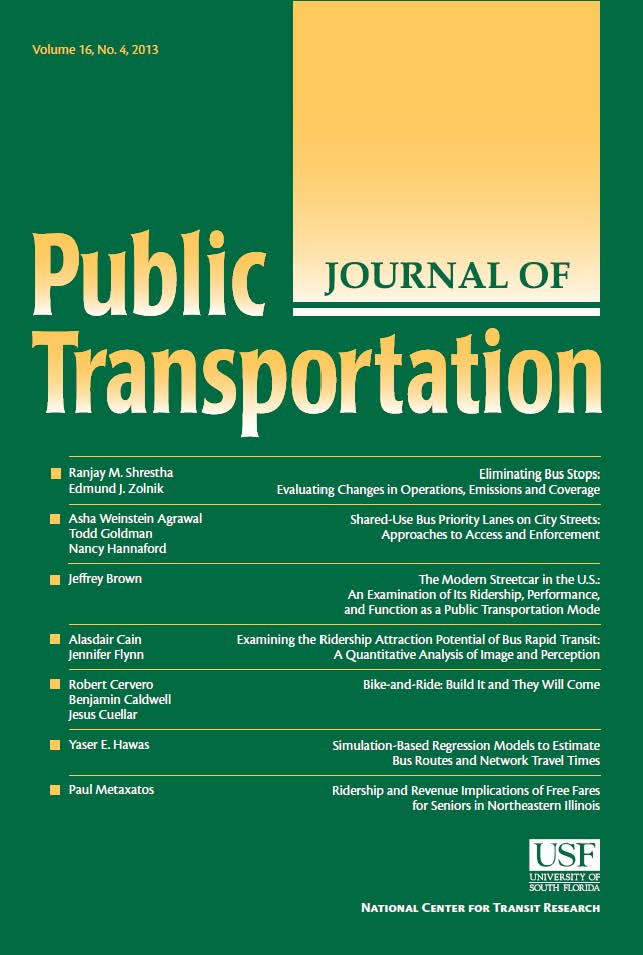Exploring changes in station catchment areas after opening new urban rail transit lines using cellular signalling data
IF 2
4区 工程技术
Q3 TRANSPORTATION
引用次数: 0
Abstract
Improving the accuracy of demand forecasting and increasing ridership are imperative for ensuring urban rail transit’s sustainable development. However, the station catchment area, which is important for planning and operation in URT, was commonly oversimplified in previous studies and cannot be validated due to limited data availability and accuracy. Furthermore, how station catchment areas change with topological changes in urban rail transit networks has been sparsely investigated. This study explores changes in station catchment areas after opening new urban rail transit lines. Using cellular signalling data from Shanghai in November 2019 and 2023, it analysed passenger trips related to three new lines (Lines 15, 14, and 18) and their adjacent stations. Comparative analysis and visualisation techniques were employed to analyse the changes in areas and centroids of station catchment areas, the source of induced passengers and the diversion patterns among new and existing stations. Results show significant differences in area and centroid changes between existing stations within and outside the influential area of new lines. The relative location of existing and new lines and transfer status change were key factors influencing the changes of existing stations affected by new lines. Among frequent and super passengers of new lines, approximately 75 % had infrequent usage of the entire rail transit system before the opening of new lines, and about 5 % who used the system frequently developed new travel demands associated with the new lines. Notably, only 2 % diverted from existing lines. Both the average access and egress distance of induced passengers and the weighted average diversion distance were influenced by the station density of the areas that new lines pass through. Although the majority of diverted passengers were from close stations on parallel existing lines, some passengers who lived in the previously underserved areas may divert from distant stations to the new lines. The findings can facilitate a more accurate station ridership forecasting for proactive planning of URT and can provide policy implications for increasing ridership.
利用蜂窝信号数据探索开通新的城市轨道交通线路后车站集水区的变化
提高需求预测的准确性,增加客流量是保证城市轨道交通可持续发展的必然要求。然而,在以往的研究中,由于数据的可用性和准确性有限,车站集水区通常被过度简化,无法验证,这对城市轨道交通的规划和运营至关重要。此外,关于城市轨道交通网络中车站集水区如何随拓扑变化而变化的研究也很少。本研究探讨城市轨道交通新线路开通后车站集水区的变化。该研究利用2019年11月和2023年上海的手机信号数据,分析了三条新线路(15号线、14号线和18号线)及其邻近车站的乘客出行情况。采用对比分析和可视化技术,分析了车站集水区的面积和中心点的变化、诱导乘客的来源以及新旧车站之间的分流模式。结果表明,新线影响区内外既有站点的面积和质心变化存在显著差异。既有线与新线的相对位置和换乘状态变化是影响新线影响下既有站变化的关键因素。在新线路的常客和超级乘客中,大约75% %的人在新线路开通之前不经常使用整个轨道交通系统,大约5% %的人经常使用该系统,并产生了与新线路相关的新旅行需求。值得注意的是,只有2% %从现有线路改道。诱导旅客的平均出入口距离和加权平均导流距离均受新建线路途经区域站点密度的影响。虽然大多数改道的乘客来自与现有线路平行的近站,但一些居住在服务不足地区的乘客可能会从较远的车站改道到新线路。研究结果有助于更准确地预测城市轨道交通的客流量,并为提高客流量提供政策建议。
本文章由计算机程序翻译,如有差异,请以英文原文为准。
求助全文
约1分钟内获得全文
求助全文
来源期刊

Journal of Public Transportation
TRANSPORTATION-
CiteScore
6.40
自引率
0.00%
发文量
29
审稿时长
26 days
期刊介绍:
The Journal of Public Transportation, affiliated with the Center for Urban Transportation Research, is an international peer-reviewed open access journal focused on various forms of public transportation. It publishes original research from diverse academic disciplines, including engineering, economics, planning, and policy, emphasizing innovative solutions to transportation challenges. Content covers mobility services available to the general public, such as line-based services and shared fleets, offering insights beneficial to passengers, agencies, service providers, and communities.
 求助内容:
求助内容: 应助结果提醒方式:
应助结果提醒方式:


